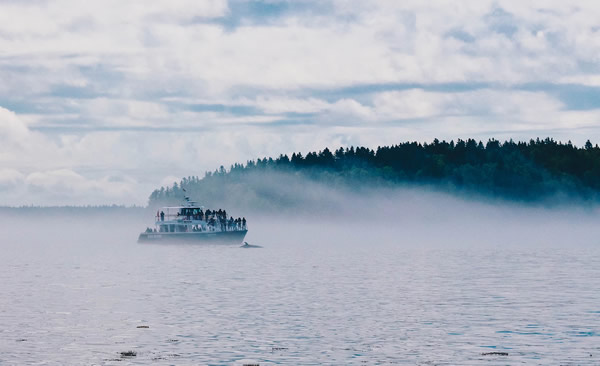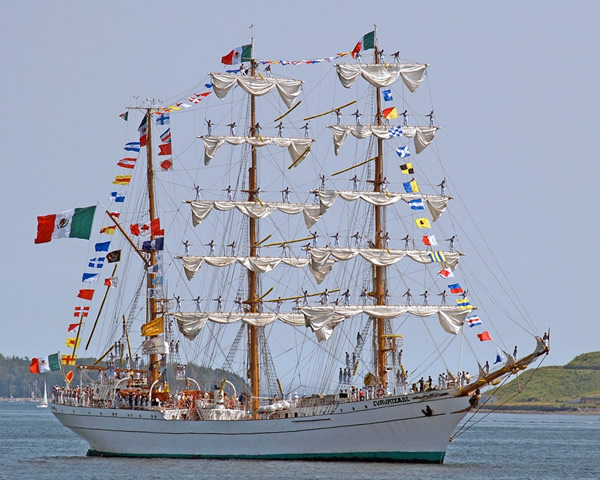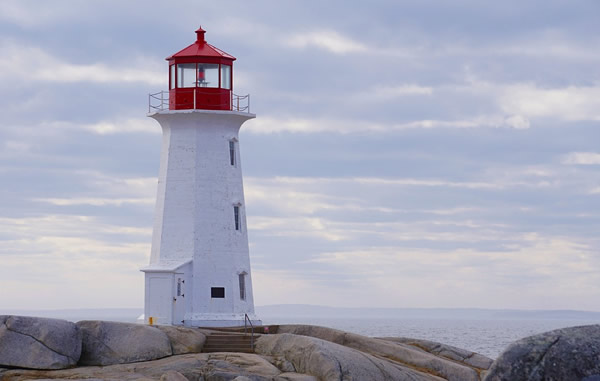Travel to an Enchanted Land in Canada
Get to Know Northern Nova Scotia
By Rob Sangster

|
|
Whalewatching in Nova Scotia.
|
Many Americans think of Canada as a northern extension of Maine, Michigan, and Montana that blends quickly into the Arctic. And they imagine that Canadians live and think pretty much like Americans. Not even close! For example,
take the maritime province of Nova Scotia.
Where Exactly Is Nova Scotia?
Nova Scotia, the easternmost Canadian province, is an almost-island in the Atlantic Ocean, barely attached to the province of New Brunswick. As the whale swims, it’s about 60 miles east of Maine across the Bay
of Fundy. For perspective, from Yarmouth (one end) to Sydney (the other) is 450 miles (about 9 hours if one were so foolish as to drive straight through). A Canadian province is a political division similar to a U.S. state. Canada’s 10
provinces and three territories add up to the second largest country in the world.
Who Are These Folks?
The Nova Scotian heritage is mostly Scots, English, Irish, French, German, and Mi’kmaq, and they enjoy a relaxed lifestyle and sense of community fast disappearing in the “States.” They also look
more toward their roots in Europe and Great Britain than is common in the U.S. In fact, many speak Gaelic, French, or German as well as English.
And about the Arctic? Well, Nova Scotia is the same latitude as Portland, Oregon — and enjoys a lot more sunshine.
Nova Scotia is filled with daring sailors, hardy fishermen and lumberjacks, lots of artists, writers, craftsfolk, and computer scientists. Most are attentive to politics on the global stage and very independent in
outlook. They’re usually willing to share informed points of view, so be prepared for a barb or two concerning current U.S. foreign policy.
Want to see how they live? Go out for a day on a lobster boat, keeping an eye out for humpback or beluga whales. Or flyfish for salmon or trout. Take a walk through the forests of the “Christmas tree capital
of the world.” Drop by a yacht club and accept an invitation for an afternoon sail. Stop into a boat builder’s workshop or an artist’s studio. And, everywhere, talk with local people.
Life by the Sea

|
|
A tall ship in Halifax.
|
Nova Scotia is a land of horizontal beauty: tranquil lakes, cool balsam fir, beech and maple forests, and rugged coastlines. Picture white 2-story homes with lots of gables, red barns, and lighthouse beacons piercing
the night sky. Imagine fishing villages, stacks of weathered lobster traps, and Cape Island dories tugging at their mooring buoys. Think of good roads, reasonable prices, and no need to lock your door.
Time is measured by the powerful rhythm of the tides. In the Bay of Fundy the tide rises and falls as much as 50 feet, perhaps the greatest tidal change in the world.
Unfortunately, Nova Scotians are in the grip of an economic tide as well, one from which no lighthouse can protect them. When lobster, cod, salmon, haddock, and herring were plentiful, prosperity reigned. Now that
marine life is struggling to recover from international over-fishing, people are struggling as well. The future of the economy is far less predictable than the tide.
So Nova Scotia has started down a path with uncertain footing; that is, the pursuit of tourists to provide replacement revenue. Services and information available to tourists rank with New Zealand as among the best
in the world. This attempt at seduction has also shifted some resources into lodging, restaurants, and resorts, as well as into the development of historic and scenic attractions.
The Vikings
One good way to begin a visit to Nova Scotia is to board the “Cat” ferry leaving from Bar Harbor, Maine and cross the Bay of Fundy to Yarmouth. It’s a tiny harbor visited by Vikings a thousand years
ago, long before Columbus “discovered” America. In the mid-1700s, merchants from Massachusetts sailed into this harbor and established the port.
Today, Yarmouth (pop. 7,500) is distinguished by its superb variety of residential architectural styles. Prideful ship captains, competing with one another to build the grandest home, chose Queen Anne Revival, Second
Empire, Gothic Revival, Georgian, and even Italianate designs. Wandering the shady streets of Yarmouth is like visiting an open-air museum.
The Evangeline Trail
Following the Evangeline Trail, the winding coast route northeast from Yarmouth, takes visitors through villages where the French-Acadian influence remains evident, especially in the fine food. Many of the ancestors
of today’s residents, who were of French heritage, were driven out of pro-British Canada in 1755, not long before the American Revolution. Many wound up in Louisiana where we know them as Cajuns.
Four miles upriver from the port of Digby, renowned for “sweet scallops,” lies the tiny village of Bear River inhabited by a quirky mixture of artists, First Nation people, farmers, and American emigrants
from the Vietnam era. The builders of great sailing vessels have been replaced by a lively community of artists.
In 1605, the French captain of one of Champlain’s supply ships, Simon Imbert, sailed into the river to take refuge from a storm. The river was later given his name. After the expulsion of the French and occupation
by the English, the name was corrupted from Imbert to Bear. And that’s the way history works.
First Capital of New France
From Bear River, a traveler might drive south across the heart of the province through dense pine and spruce forests to the South Shore, Nova Scotia’s Riviera. Near where the scenic LaHave River flows into the
Atlantic, the French adventurer Champlain dropped anchor in 1604. In 1632, Commander Isaac de Razilly, on orders from the French king, founded a colony nearby and proclaimed it the First Capital of New France, one of the first permanent settlements
in North America.
Port of Lunenburg
In Lunenburg, just up the coast, brightly painted Victorian homes rise up the hillside behind a bustling waterfront. Boat builders and ship chandlers still ply their trades. Lunenburg is so picturesque it’s
been the setting for more than a dozen motion pictures. The entire center of town was chosen as a World Historical Site.
The tall ship Picton Castle takes on provisions as it prepares to sail away for 18 months. To supplement a core crew of seasoned sailors the captain signs on 20 novices eager to accumulate treasures from exotic stops
during the ship’s global journey. Maybe he has a spot for you.
Lighthouse Route

|
|
A lighthouse in Halifax, Nova Scotia.
|
The Lighthouse Route leads farther up the coast through Mahone Bay, home of the famous Wooden Boat Festival, and on to the city of Halifax, capital of the province. It’s an easy-going place (pop. 400,000) sheltered
by a long, narrow channel from the rambunctious sea.
Headstones in Halifax are a reminder of the trans-Atlantic travelers aboard the great ship Titanic who were gently reclaimed by Nova Scotians from an ice-choked sea long ago.
Cape Breton
Cape Breton is a granite island connected to Nova Scotia only by a short man-made causeway. It’s almost cloven in half by the 100-km long Bras d’Or Lakes, home to lobster, bald eagles, and visiting moose.
Gilbert Grosvenor, Chairman of the National Geographic Society, said, “The Bras d’Or Lakes are my favorite landscape on planet Earth.”
The lakes are also the spiritual capital of the Mi’kmaq nation, the indigenous people who had inhabited Nova Scotia for thousands of years before Erick the Red, Hudson Bay Company trappers, and Champlain dropped
in.
National Geographic Traveler rated Cape Breton as the number two tourism destination (for sustainable travel) in the world, tied with the South Island of New Zealand and Torres del Paine in Chile.
The trademarks of Cape Breton are the music and dress of Scotland and the cadence of the Gaelic language. The main attractions for many visitors are challenging hikes, rocky cliffs, vivid colors, and abundant wildlife
in the rugged national park.
For an unforgettable insight into the unique culture of Cape Breton, and for a rollicking good time, consider the Celtic Colours International Festival. More than 250 musicians, singers, dancers, and storytellers
gather each year in early October, just when the leaves are bursting to fall colors.
Leaving Cape Breton on the Cabot Trail the road winds along the edge of a steep drop. Far below, seals and Beluga whales play in the turquoise sea.
Feed Your Senses
Nova Scotia is a place to smell the salt air, to spend a day sailing with a hard-handed lobsterman; a place to dance with the Scots and eat with the Acadians. Imagine what it might be like to live in such a place.
How to Get the Most out of Visiting Nova Scotia
1. Visit off-season, because lodging is limited during the summer.
If you reserve lodging before you leave home you lose flexibility, but without reservations a perfect day may be spoiled by a search for vacancy. The solution? Visit before July 1 or after Labor Day and you’ll
have no trouble finding accommodation. Consider October when the leaves burst into brilliant colors.
2. Skip hotels and motels. Except for a few classics, most are ordinary and mildly expensive. Instead, choose a bed and breakfast, a country inn, or a farm home. They have character, cost less,
and give you the opportunity for conversation with friendly local folks.
3. Get all the information you need for free at the Nova Scotia Tourism Office, including:
-
High-speed "CAT" car ferry from Bar Harbor
to Yarmouth.
-
Museums, including information on the First Capital of New France.
-
Stop at the Visitors Information Center when you enter the province. There are also VICs in most of the towns throughout the province.
4. Consider granting yourself two weeks or more, and start your travels in Boston. Follow the history-rich roads north through Massachusetts, New Hampshire, and Maine. Then catch the ferry or continue north through
New Brunswick. Return from Nova Scotia via Prince Edward Island, home of Anne of Green Gables.
|
ROB SANGSTER writes and sails in LaHave,
Nova Scotia, Canada. See his bio for more articles written for Transitions Abroad.
|
